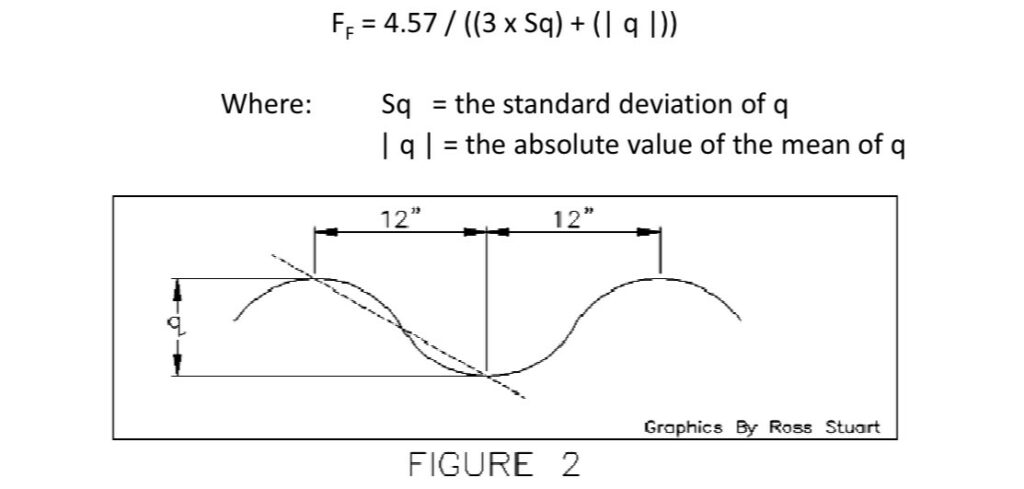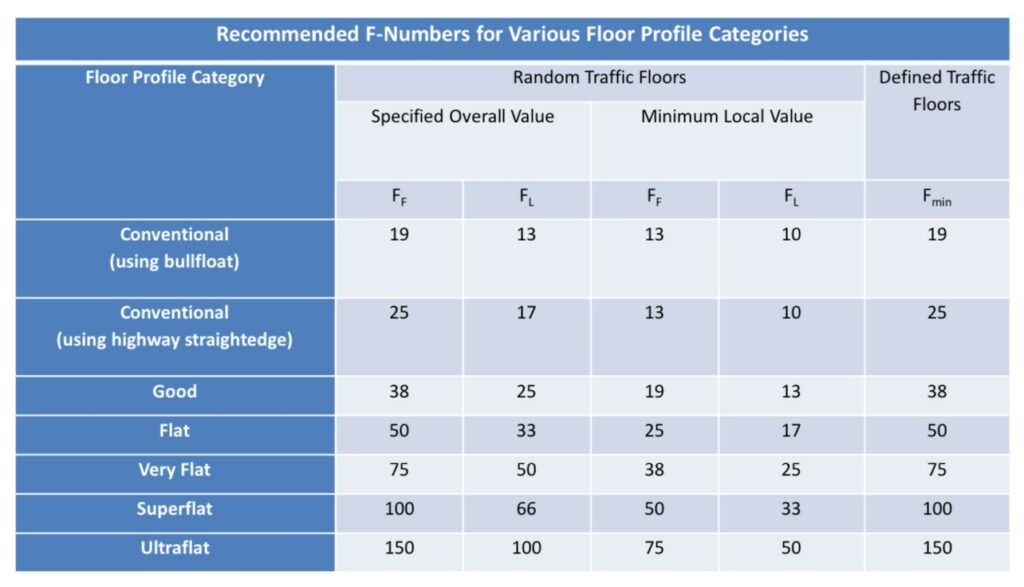Starting in the 1970’s, ACI targeted the conventional 1/8” in 10’-0” floor finish, or “straightedge spec”, as an area that needed more uniform and realistic methods of specification and monitoring. This need was felt because of the ambiguous nature of the traditional straightedge specification. For example 1/8″ in 10′-0″ could mean either of the two conditions shown in Figure 1 below.
In addition, the straightedge method had no standard test method; therefore field conditions were often subject to interpretation. For example does the spec 1/8″ in 10′-0″ mean that measurements are taken at points both 360° and 90° from each other? Are measurements cumulative along lengths greater than 10’-0”? Finally, the straightedge specs do not address floor flatness (roughness or wash boarding) or levelness (tilt or slope).

What are F-Numbers?
The F-Number system is a statistical method of evaluating horizontal concrete surfaces for flatness and levelness. The Face Company, in conjunction with ACI Committee 117, developed the basis for the system through the use of a patented continuous Profileograph machine. For a typical random traffic industrial or other similar floor slab there are two F-Numbers used to evaluate the floor flatness and levelness, FF and FL; respectively. FF (flatness) is most affected by the finishing operation. FL (levelness) is most affected by forming and strike-off. Both numbers are dimensionless and the higher the number the more accurate the floor construction.
The FF number relates to the rate of change of the elevation of a concrete floor over a 12″ interval. The rate of change of slope is represented by the value q. A hump in a slab produces a negative q value while a trough or depression produces a positive q. FF is calculated using the following formula:

The FL number relates to the general floor slope of a concrete slab from an assumed datum elevation. The difference in elevation of two points which are 10′-0″ apart are measured as the value z. FL is calculated using the following formula:

For defined traffic industrial floor slabs, such as very-narrow-aisle warehouses where forklifts travel the same path, an Fmin numerical system is used. Fmin is not calculated like FF or FL. Fmin is actually a direct measurement of the floor surface in the wheel path of the forklift for which the defined traffic area is designed. An Fmin100 specification is a baseline number corresponding to a flatness tolerance of 1/8″ in 10′-0″. An Fmin50 specification corresponds to a flatness tolerance of 1/8″ in 5′-0″, or 1/4″ in 10′-0″.
How are F-Numbers Specified?
ACI 117 is the industry standard for the use of the F-Number system and establishes the F-Numbers of different types of floors as well as the definitions of acceptable variances. ACI 302 also provides guidelines for the placing and finishing of concrete floor slab construction for the F-Number system.
ASTME1155 is the basis of the standard test method for the FF and FL number system. One of the most important aspects of establishing F-Numbers is to not over specify beyond that which is really required for a given project. This is because an increase in required floor quality will almost always result in higher costs. One of the best methods for determining the most appropriate criteria to specify for a project is to measure existing floors that are performing satisfactorily. Specifications should state the performance criteria only and not specify the method of obtaining the required tolerances. This is recommended because the quality of work varies from finishing crew to finishing crew for any given standard technique used in the field.
FF and FL are typically specified for both overall and minimum local values. This helps prevent the acceptance of isolated local areas of low quality construction due to it being averaged in with other areas of the slab that surpass the minimum requirements. The specified overall values describe the flatness and levelness values that must be achieved when all measured values on a given test surface are combined. The minimum local values describe the flatness and levelness values below which repair or replacement is required within the affected area. The general rule of thumb is that the local area minimum must be within 2/3 of the specified overall value. On elevated slabs the FL levelness tolerance does not apply because of the deflection of the overall framing system and should therefore not be specified. Only FF numbers should be specified for elevated slabs.
Lift and forktruck manufactures publish recommended Fmin floor tolerances to assure the proper operation of their equipment. The higher the number the flatter and more level the floor requirement is. Fmin100 is typically referred to as a “Superflat” floor requirement. Producing an Fmin100 tolerance in any direction on a floor is comparable to producing a floor surface meeting FF140 and FL100 tolerances.
An additional ASTM specification, E 1486 can be used to determine the deviation from a 10-foot straightedge for both random and defined traffic floors in order to determine the “Waviness Index”. In addition this specification provides defined wheel track equations for specifying elevation differences and change in elevation transversely between left and right wheel tracks and longitudinally from front to rear axle , therefore this spec can be used as a standard for evaluating Fmin floor tolerances.
The following table can be used as a guideline for specifying F-Numbers for various floor profile categories:

In addition, although there is no direct equivalence between F-Numbers and traditional straightedge specifications the following table provides an approximate correlation between straightedge measurements and FF Numbers.

How are F-Numbers Measured?
Floor flatness and levelness tests should be conducted anywhere from within 16 to 72 hours after completion of the final troweling operation, depending on the project type and requirements. As it is typically not practical to obtain acceptable local values across construction joints it is recommended that these areas be omitted from consideration for comparison to the specified minimum local value. It should also be noted that it is entirely possible that the floor can be within specified tolerances during the initial testing process but become out of spec prior to actual use because of slab cracking, curling or sub-grade settlement.
ASTM E1155 is the governing specification for the testing procedures used to determine floor flatness and levelness for random traffic floors. This standard allows for numerous techniques for gathering the required date including levels, inclinometers, Profilometers and other means. One of the most often used pieces of equipment for these measurements is the Dipstick floor profiler, an apparatus that can field measure both floor flatness and levelness. This equipment can be programmed to measure floor slabs on slopes also.
For defined traffic floors such as rack aisleways where the wheel traffic occurs in the same location for all operations, instead of random sampling, traffic paths are directly measured using a continuous recording floor Profilometer configured to run in exactly the same specified wheel tracks as the forktrucks. The results of the measurements taken do not produce F-Numbers, but instead simply confirm compliance with the minimum requirements specified. Changes in elevation and rate of change are confirmed in both the longitudinal and transverse direction of the wheel travel. The record of measurements indicates the exact location of any areas that are not in compliance.


Hi
It was very hard to finally find the formula you give above for calculating FL. Thank you for publishing it. I am not a math whiz – can you clarify, what unit is used for z in the formula for calculating FL, decimals of a foot, or decimals of an inch?
Thanks
he is right
Hi,
I’m an architect and wondering if you have a 1-hour training course for Concrete Slabs and the Use of the F Number System for our company?
Thanks!